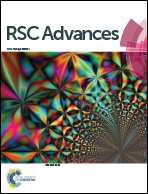Roles of solvent, annealing and Bi3+ co-doping on the crystal structure and luminescence properties of YPO4:Eu3+ nanoparticles†
Abstract
YPO4:Eu3+ nanoparticles have been prepared in different solvents such as polyethylene glycol (PEG), PEG-diacid and water. These nanoparticles crystallize in a mixture of tetragonal and hexagonal phases. The ratio of tetragonal to hexagonal phases in PEG and PEG-diacid mediums is much lower than that in water. Interestingly, luminescence intensity upon excitation at 260 and 395 nm for the sample prepared in water is higher than that for the sample prepared in PEG or PEG-diacid. This is because of association of water molecules trapped inside the pores of the hexagonal phase and this induces a non-radiative rate. In order to study the effect of Bi3+ co-doping on the luminescence intensity, we have carried out detailed crystal structure evolutions in different solvents. However, the luminescence intensity decreases significantly upon Bi3+ co-doping because it enhances conversion of a mixture into the hexagonal phase. Upon heating at 900 °C, the luminescence intensity increases significantly because of the conversion of hexagonal to tetragonal phase. An increase in the lifetime value of Eu3+ as well as the red light enhancement has been observed in 900 °C heated samples by Bi co-doping.


 Please wait while we load your content...
Please wait while we load your content...